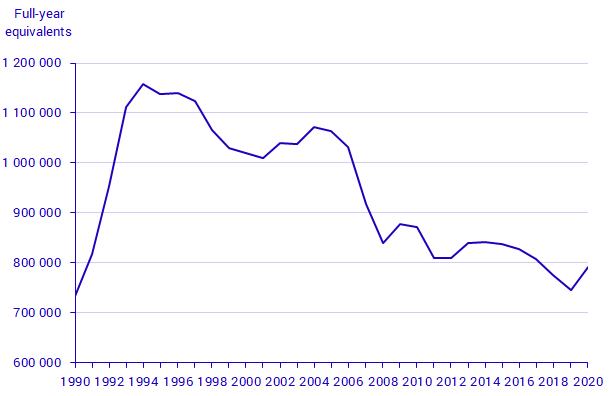Number of full-year persons receiving social assistance and benefits 2020
Number of persons receiving economic support increased
Statistical news from Statistics Sweden 2021-03-24 9.30
The number of full-year persons receiving economic support in the form of social assistance and benefits increased by 6.0 percent in 2020. The total number in 2020 was 790 242 people, which corresponds to 13.4 percent of the population of working age. This share was lowest in commuter municipalities close to a large town, at 10.4 percent, and highest in rural municipalities and commuter municipalities close to a small town, at 16.4 percent.
Statistics Sweden annually reports statistics on the number of full-year persons aged 20–64 who receive economic support in the form of social assistance and benefits. These comprise sickness benefits, sickness or activity compensation, unemployment benefits, labour market policy measures, economic aid, and introduction benefit.
Different types of benefits can be made comparable by using ‘full-year equivalents’, that shows how many individuals could be supported during an entire year on full benefits. For example, two persons who have both been unemployed full-time for six months together amount to one full-year equivalent.

The number of full-year equivalents receiving social assistance and benefits rose by almost 60 percent between 1990 and 1994. Since then the figure has dropped steadily, and in 2019 it was almost at the same level as in 1990. However, between 2019 and 2020, the number of full-year equivalents increased. In 2020, unemployment benefits and labour market measures were the forms of compensation that increased, while economic aid, sickness benefits, sickness or activity compensation and introduction benefit decreased.
Sickness and activity compensation, which is the largest form of compensation and accounted for about 29 percent of the total number of full-year equivalents, has decreased since 2006. In 2020, this form decreased by 4.5 percent and has thus decreased by 50.1 percent since 2006.
The largest contribution to the rising number of full-year equivalents in 2020 came from the unemployment benefits form of compensation; it increased by 55 percent over the year and accounts for almost the whole increase in the number of full-year equivalents.
Introduction benefit was introduced in 2011 and the number of full-year equivalents for this form of compensation increased sharply until 2017. However, in the last three years this number has decreased sharply; in 2020 it decreased by 37 percent.
Major regional differences
The proportion of full-year equivalents who received social assistance and benefits varies across the country. Among the population aged 20–64 years, the proportion of people who received social assistance was lowest in Stockholm County at 10.6 percent and highest in Gävleborg County at 18 percent. The difference between these counties was largest among the share of the population in labour market policy measures; In Stockholm County this proportion was 2 percent, while in Gävleborg County it was 5.6 percent. Between 2019 and 2020, the proportion of full-year equivalents increased in all counties.
At the municipal level, the differences were even greater. In 2020, the proportion of full-year equivalents was lowest in Danderyd at 6.1 percent and highest in Ljusnarsberg at 23.1 percent.
In a classification based on size and location of the municipality (according to SALAR’s municipality group classification), the proportion of people who received social assistance and benefits was on average lowest in commuter municipalities close to a large city at 10.4 percent, and highest in rural municipalities and commuter municipalities close to a small town at 16.4 percent. Between 2019 and 2020, this proportion increased in all municipality groups.
| Municipality group | Percentage |
|---|---|
| Commuter municipality close to a large town | 10.4 |
| Rural municipalities with a visitor industry | 12.2 |
| Large cities | 12.7 |
| Medium-sized towns | 13.9 |
| Commuter municipality close to a medium-sized town | 14.2 |
| Small towns | 14.4 |
| Low-commuter municipality close to a medium-sized town | 16.1 |
| Commuter municipality close to a small locality | 16.4 |
| Rural municipalities | 16.4 |
More women than men
Among the full-year equivalents in 2020, 53.5 percent were women and 46.5 percent were men. The distribution between women and men has been roughly unchanged since 2006 when the information was first reported broken down by sex. Women are in a clear majority in the compensation form "sickness benefit".
Unemployment benefits and labour market policy measures are the only forms of compensation for which there are more men than women.
| Women | Men | Total | |
|---|---|---|---|
| Sickness benefits | 63.8 | 36.2 | 100.0 |
| Sickness or activity compensation | 55.9 | 44.1 | 100.0 |
| Unemployment benefits | 44.5 | 55.5 | 100.0 |
| Labour market programmes | 48.3 | 51.7 | 100.0 |
| Economic aid | 51.4 | 48.6 | 100.0 |
| Introduction benefit | 59.6 | 40.4 | 100.0 |
| Total | 53.5 | 46.5 | 100.0 |
Statistical Database
More information is available in the Statistical Database
Feel free to use the facts from this statistical news but remember to state Source: Statistics Sweden.
